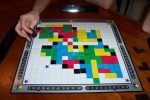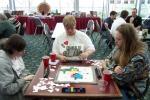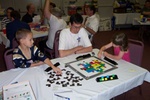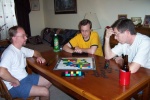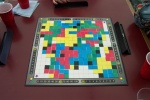
|
Tilez! A game by Andy and Elliot Daniel Published by Enginuity LLC Players: 2 to 4 Time: 30 minutes Reviewed by Ed Rozmiarek |
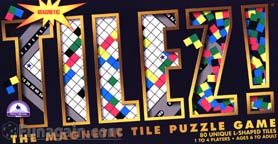
Picture courtesy of FunAgain Games |
Tilez! (also known as Tylz!) is a simple, abstract tile laying game. I first played this game at Gulf Games 11 in February 2003 and it went on my "buy" list right after. This is an older game from an American publisher that has not seen much press in the German game circles. However, with its simple rules and 30 minute play time, it could have easily been a published by a European publisher (probably with some paper thin theme pasted on).
Components: The components of the game are pretty basic. The mainly white board is made up of a square 17 by 17 grid with nine colored starting squares placed on the board (five neutral black squares and one each red, blue, green and yellow). There are also twelve squares on the board marked with a star (these are used for scoring, more on this later). Along each side of the board is a score track, one for each player. The score track consists of two rows on numbers, the ten's row (0, 10, 20, etc) and the one's row (0, 1, 2, 3, etc). Players keep track of their score by marking the two numbers that make up their score. For example, if a player's score is 26, he would mark the 20 and the 6.
The playing pieces are 80 'L' shaped pieces, each of which consists of three squares in a random assortment of five colors. There are four scoring colors (red, blue, green and yellow) and one neutral color, black. Each piece when played on the board will cover three squares.
The game also comes with four player racks to hold the player's tiles. The racks are functional but pretty flimsy, being made out of very light weight plastic.
The first copy of the game I played contained a regular board with light weight cardboard tiles. When I bought my copy, it was a "magnetic" version. The board is a little heavier and (must) contain a thin metal surface in the middle. The tiles themselves are magnets (think refrigerator magnets). This is nice because the tiles will stay in place on the board but it is a little bit of a hassle at the start and end of the game. First, at the start of the game you must separate the pieces which have most likely gotten stuck together in the box and at the end you must peel them off the board.
Game play: The game play in Tilez! is pretty straight forward. Each player starts with three tiles that he keeps hidden from the other players. On his turn, a player plays one of his tiles on to the board, scores the play and draws a replacement tile. If the player scores (see below) three or more points with his play, he may go again. A player may make several plays in a row if he continues to score three or more points.
When a tile is placed on the board, it must meet certain criteria to be a legal play. The criteria are:
- The tile must be placed so that at least one edge matches a neighboring square.
- The tile may not overlap another tile or colored start square.
- If more than one edge of a single a square of the tile touches more than one other filled in neighboring square, at least one edge must match. This is easier to show then write and there are several examples of this in the rules.
- Black is considered neutral and matches any other color.
Players score points based on the number of edges they match when they place their tile. One point is awarded for each matching edge. If the player matches three or more edges with is play, he gets to play again. If the player covers a star while playing his tile, his points for that move are doubled. (Note: To take another move, the player must score 3 or more points via matching edges, not via doubling is score with a star.)
The game ends when no player may make a legal move. At that point, the player with the most points wins.
There is a variant rule for the game which one can use to make the game easier for younger players. This variant relaxes the placement rules and allows any tile to be placed as long as at least one edge matches another color.
Commentary: If you are looking for a deep strategy game, you're not going to find it with Tilez!. However, if you are looking for a lighter, family game, Tilez! should fit the bill. With the simple tile placement mechanism, the game is very easy to teach and can be played with young children. We have played with our two boys and they both caught on to the game quickly and did well. In fact, our 7 year old mastered the game so well that he started to point out moves to other players.
Many times, the game comes down to having the right tile at the right time. When playing, almost every play should result in at least two points. The three point plays is what the players really look for. Not only do they get you more points, but the allow you to get an extra turn. Getting really lucky and having two or more three point plays in a row can be very beneficial. About the only real thing to watch out for are the stars on the board. You should try not to play a tile near a star and leave another player a chance to cover the star. Of course, you can't always do this as the board fills, but leaving an opponent an easy 4 or 6 points is not good.
Conclusion: I have found Tilez! to be a enjoyable, light weight family game. This falls into the group of games we call "TV Games", games that you could play while watching TV. I would rate the game a 7 out of 10 ("Good game, usually willing to play") on the Boardgame Geek rating scale. The game gets extra points from me as it is something I can get my boys to play.
Other Web information:
This page viewed
E-mail Ed Rozmiarek with questions or problems concerning this page.
Copyright © 2003, Ed Rozmiarek
